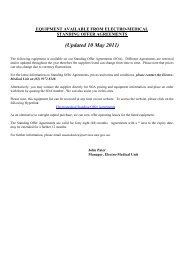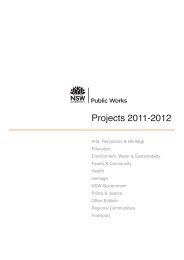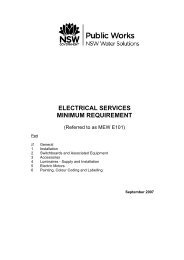Download MEW E101 April 2013 (pdf, 280kb) - NSW Public Works
Download MEW E101 April 2013 (pdf, 280kb) - NSW Public Works
Download MEW E101 April 2013 (pdf, 280kb) - NSW Public Works
You also want an ePaper? Increase the reach of your titles
YUMPU automatically turns print PDFs into web optimized ePapers that Google loves.
Part 1 - Installation<br />
A separate MEN system for each building shall be used except where an earthing<br />
conductor is indicated to be run with the submain to that building.<br />
Metallic pipes used for other services, such as gas, water, sprinkler systems, etc., shall<br />
be considered as unavoidably in contact with metallic enclosures of electrical equipment<br />
and shall be effectively bonded to the earthing system.<br />
107.2 Earthing Conductors for Underground Cables<br />
Earthing conductors other than the copper sheathing of MIMS cables shall be copper<br />
stranded conductors sized as per AS 3000, protected by a green-yellow insulation and<br />
installed as follows:<br />
(a) Separate earthing conductors for TPI conductors in conduit.<br />
(c) Separate earthing conductors attached to the cable at 1000 intervals.<br />
(c) Earthing conductors laid up with the cable.<br />
107.3 Earth Electrodes<br />
Earth electrodes shall consist of copper, stainless steel or copper sheathed rods not less<br />
than 16 diameter driven to a depth of not less than 2400 to reach the permanent<br />
moisture level. Unless disallowed by the Supply Authority, the indicated footing in each<br />
building shall be used as an electrode in addition to the above. The earthing conductor<br />
shall be connected to the reinforcing steel of the indicated footing and the driven<br />
electrode. Each electrode shall generally be installed in an earthing pit similar to<br />
"Polycrete" PEP 22. Each pit shall have a reinforced concrete surround minimum 250<br />
wide and 200 deep complete with cable markers.<br />
108 CONDUITS, FITTINGS AND JOINTS<br />
108.1 Generally<br />
Conduits and fittings shall comply with either AS 2052 "Metallic conduits and fittings" or<br />
AS 2053 "Non Metallic conduits and fittings". Conduits smaller than 20 dia. shall not be<br />
used except for fire alarm systems where 16 dia. will be accepted.<br />
Conduits shall be in long lengths, straight, smooth and free from rags, burrs and sharp<br />
edges. Off cuts shall not be used to fabricate long lengths of conduit. Conduits shall be<br />
set wherever possible to minimise the number of joints.<br />
Bends shall be of large radius and shall be formed with approved formers. Correctly<br />
sized springs shall be used to form bends in UPVC conduits. Conduits manipulated or<br />
bent must maintain true effective diameter and shape at all parts of the bend. Conduit<br />
sets distorted or showing evidence of kinks, wrinkles, flats or having been heated will not<br />
be accepted. Wherever possible, UPVC Conduits bends should be preformed by the<br />
manufacturer.<br />
Conduits shall be colour coded in accordance with Clause 602 of <strong>MEW</strong> <strong>E101</strong>.<br />
Saddles supporting conduits shall be effectively secured to the surface on which they<br />
run. Saddles shall be a proprietary brand installed as supplied.<br />
Conduit systems, including conduits and pipes used to convey cables into buildings,<br />
shall be sealed to prevent water entry.<br />
The number of cables including earth wires that may be enclosed in any one conduit or<br />
pipe shall not exceed that recommended as a guide in AS 3000.<br />
All conduits exposed to weather shall be painted with a light coloured paint designed for<br />
the purpose.<br />
108.2 Heavy Duty UPVC Conduits to AS 2053 (HD-UPVC)<br />
Page 14<br />
<strong>MEW</strong> <strong>E101</strong>





